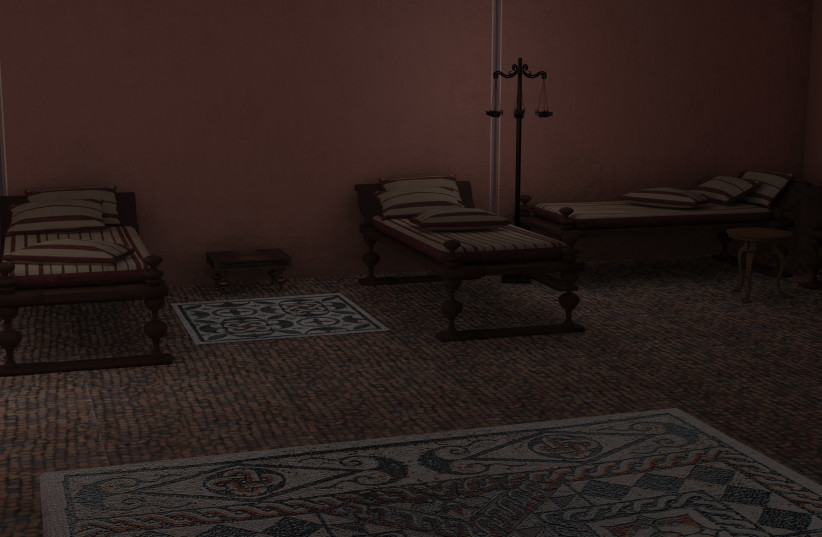A rare and well-preserved Roman mosaic was found at a salvage excavation in London near one of the city’s newest landmarks, a glass skyscraper known as the Shard.
A "a once-in-a-lifetime find"
Archaeologists from the Museum of London Archaeology (MOLA) said in a press release they believed the large mosaic was part of the floors of a Roman dining room, known as a triclinium, belonging to a high-market motel – or mansio – offering overnight accommodations, stabling and dinning for high-ranking officials and their guests.
They said the room would have been brightly painted and contained dining couches where people would recline to eat and gaze at the beautiful flooring.
“This is a once-in-a-lifetime find in London. It has been a privilege to work on such a large site where the Roman archaeology is largely undisturbed by later activity. When the first flashes of color started to emerge through the soil, everyone on site was very excited,” said MOLA site supervisor Antonietta Lerz.
It is the largest Roman mosaic uncovered in London in some 50 years and consists of two panels. Researchers estimate that the larger one dates back to the late second or third century CE. It is decorated with large, colorful flowers surrounded by bands of intertwining strands – a motif known as a guilloche, the MOLA said. Other mosaic designs include lotus flowers and several different geometric elements, including a pattern known as Solomon’s knot, made of two interlaced loops.

The Acanthus group's unique style
Dr. David Neal, former archaeologist with English Heritage and a leading expert in Roman mosaic, has attributed this design to the “Acanthus group” – a team of mosaicists working in London then known by its Roman name of Londinium – who developed their own unique local style.
The smaller panel has a simpler design, with two Solomon’s knots, two stylized flowers and striking geometric motifs in red, white and black.
The press release noted that this design is an almost exact parallel to one which has been found in Trier, Germany, and the same mosaicists were likely at work in both places.
“It provides exciting evidence for traveling Roman artisans at work in London,” the researchers said.
Archaeologists from the museum discovered the mosaic earlier in February in an area that had served as a parking lot and site where a new commercial and residential area is being planned. They said there are traces of an earlier mosaic underneath the one currently uncovered, indicating that the room had been renovated over the years, perhaps to keep up with decorating trends.
NEIGHBORING THE mansio, archaeologists have identified another large Roman building, likely to have been the private residence of a wealthy individual or family. In addition to the mosaic, fragments of colorful wall plaster, coins, jewelry and decorated bone hairpins were also found, all items which would have belonged to wealthy residents and visitors, attesting to the level of wealth people living in the area 2,000 years ago would have enjoyed.
Excavations are ongoing, but current findings suggest this was a very large complex, with multiple rooms and corridors surrounding a central courtyard, said the researchers. Most likely it was located on the outskirts of Roman Londinium, an area centered on the north bank of the Thames and roughly corresponding to the modern city of London.
The complex was built by the river crossing that led into the city and not far from the main road connecting London to other important centers in southeast Britain, including Canterbury and the cross-channel Port of Dover, providing excellent transportation links for visiting dignitaries.
The mosaics will be recorded and assessed by an expert team of conservators before being transported off-site to allow for more detailed conservation work. Following its removal researchers hope to continue with excavation work of the remains of the earlier mosaic. Future plans for the public display of the mosaics are currently being discussed.
A short history of London's Romans
The Romans invaded England in 43 CE, led by Emperor Claudius, and built a settlement on the north bank of the Thames River on the current site of the modern city of London. They established Londinium as the capital of Roman Britannia for most of their rule, and from 50 CE to 410 CE, it was the largest city in Roman Britannia and an important port city. At its height, Londinium had an estimated population of 45,000-60,000 people, so it is rare to find such complete mosaic remains in what was even then a crowded urban area.
Warrior Queen Boudicca of the indigenous Iceni British Celts tribe led a revolt against the Romans in 61 CE, reportedly after they stripped and publicly flogged her and raped her daughters when they decided to rule the tribe directly following her husband’s death. Her united forces burned Londinium to the ground but the Romans eventually retook the city and rebuilt it.
Roman remains still visible in the city of London include sections of the ancient city wall and remains of the amphitheater. Remnants of a bath house, villa, and Roman temple have also been found.
